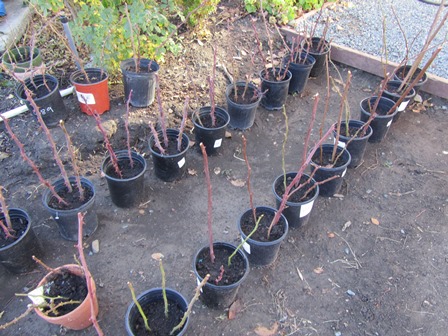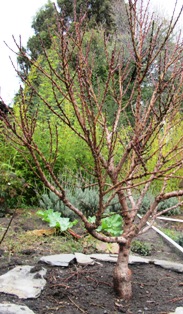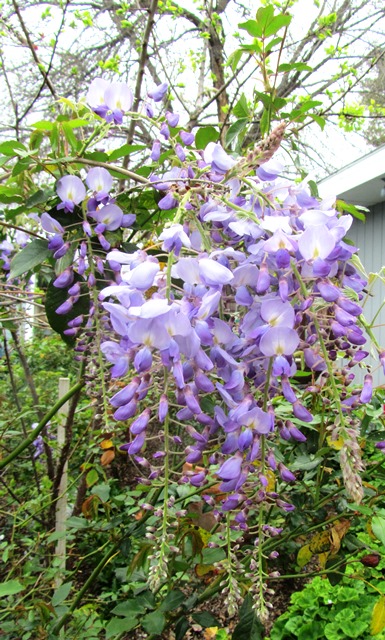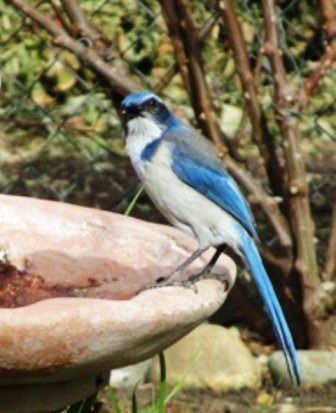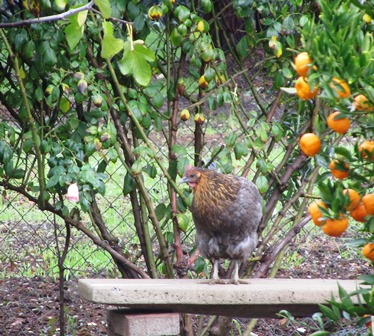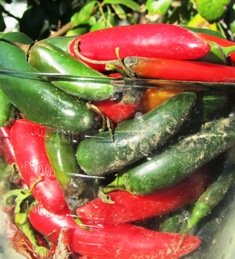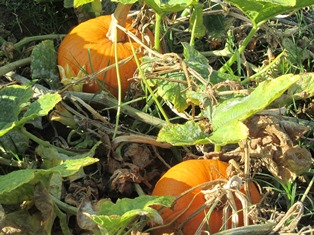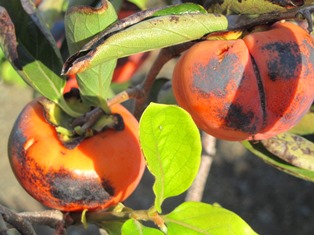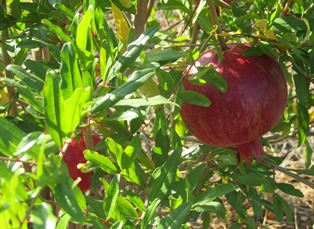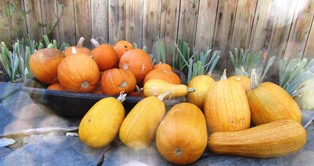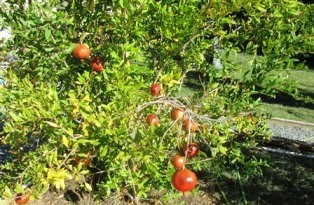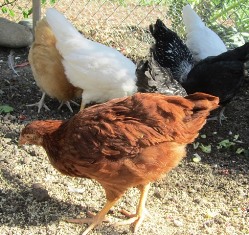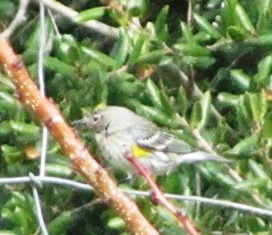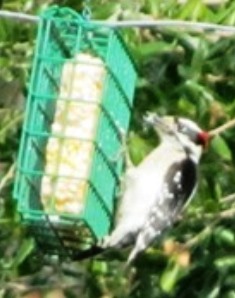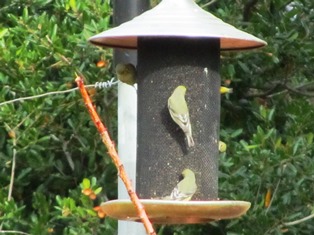Four Reasons to Buy Bare-Root Plants
Mid-February marks the beginning of bare-root season in the Bay Area. Growers ship roses, fruit trees, grapes, and berries in late January through February and March to local nurseries and DIY garden centers. By April, often sales of unsold bare-root plants begin. There are at least four good reasons to buy bare-root plants before spring officially arrives.
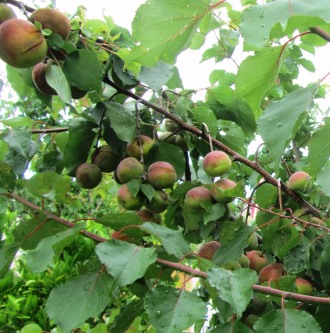
- When you buy bare-root trees, berries, grapes, and other plants in late winter (here in the Bay Area), you’ll pay less for them than you will if you wait until the start of spring. The purchase price increases later in the season. When the plants begin leafing out, nurseries will place unsold bare-root plants in pots. Potting an unsold plant involves extra labor as well as the costs for the pot, soil and amendments, mulch, and possibly stakes. Those costs are passed to the shopper.
2. It’s easy to place a bare-root tree right into your garden before its sap is flowing. When it is still “asleep,” it’s not as susceptible to cold and and won’t need as much water as it will when the weather is warm, the plant has leafed out, and the roots are growing and spreading.
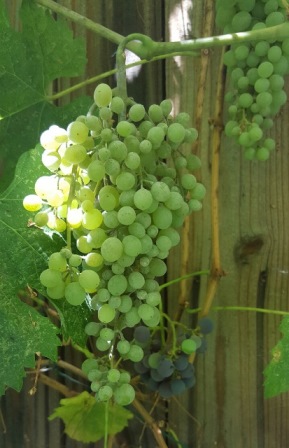
varieties of bare-root grapes.
3. Bare-root buys you time. If you are still planning your garden, you can “heal in” a bare-root plant until you are ready to put it in your garden. You just need to excavate a trench in which you temporarily place the bare-root plant. Mound soil over the roots and water. Let the plant rest until you prepare the permanent planting hole.
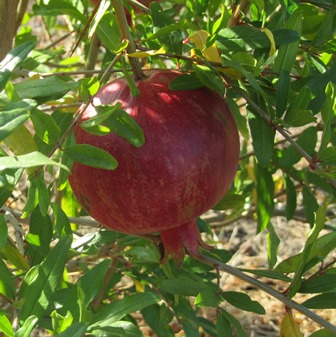
popular because they remain small and fruitful for years.
4. You have an opportunity you won’t get again to inspect the health of the root and its growth. With a bare-root plant, the roots can be examined for problems such as decay or damage. Using sharp pruning shears, you can cut away problem issues. When you buy an already potted plant, you won’t have this option.
Take a moment to visit your local plant seller, nursery, or DIY center to see what plants are available right now. Enjoy the season.
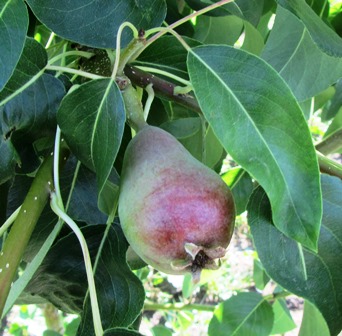
and after three years is producing dozens of late summer pears.
If you enjoy reading about country living topics, check out Meera Lester’s Henny Penny Farmette mystery series. Besides an entertaining mystery, each book includes delicious recipes, strategies for growing heirloom vegetables and fruits, and tips for keeping chickens and bees. These novels and her nonfiction self-help and wellness books are available online and everywhere books are sold.
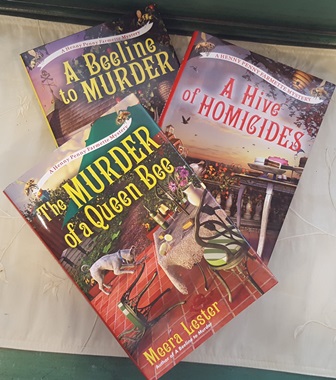
Three Reasons to Plant Bare Root
If you are someone like me who loves to garden, you have the first day of spring circled on your calendar. For 2020, spring arrives on March 19.
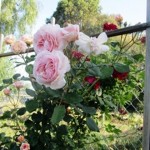
Plant bare root fragrant roses and engage in mindfulness practice. Both will have you stopping to smell the roses
Bare-root season (when fruit trees, roses, and other plants are dormant and sap is not flowing) is now. Here in the Bay Area, the soil is currently soft and makes for easy turning with a spade. Now is the time to incorporate some roses or other bare root plants into your garden. There are several reasons to do so.
1. Planting bare root saves you money. If you are buying from a local nursery or a seller who ships, you’ll find the cost cheaper because you’re not paying for soil or containers.
2. Better selection. You can purchase heirloom varieties of deciduous trees and shrubs from all over the world when you buy bare root. Bare root fruit trees are popular with back yard gardeners but you might also consider artichokes, rhubarb, strawberries, grapes, asparagus, and many other plants that are sold as bare root.
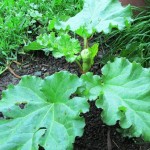
Rhubarb is a bare root plant that flourishes in rich soil with some protection against direct overhead sun
3. You have flexibility. Planting in February just before spring means the ground has thawed in areas where freezing temperatures are the norm. When the ground is growing warmer and is workable is the time to tuck your bare root plants into the soil.
________________________________________________________________________
If you enjoy reading about country living topics, check out my Henny Penny Farmette series of cozy mysteries, including A BEELINE TO MURDER, THE MURDER OF A QUEEN BEE, and A HIVE OF HOMICIDES (Kensington Publishing). These mysteries also include farm to-do lists and delicious recipes.
I’ve also written over two dozen self-help and wellness books, including THE SELF-CARE PLANNER, HOW TO LIVE WITH INTENTION, and MY POCKET MEDITATIONS (Adams Media/Simon and Schuster).
Find Meera Lester’s books online and in traditional bookstores everywhere. Barnes & Noble will be featuring THE SELF-CARE PLANNER on its self-care table for the New Year, New You promo, starting Dec. 31 and running through March 2020, in select stores.
https://www.simonandschuster.com/books/The-Self-Care-Planner/Meera-Lester/9781507211649?utm_source=author_post&utm_medium=adams_outlet&utm_campaign=adams_lead_fall&utm_content=
Pruning between Storms
The roses, fruit trees, vines, and bushes need pruning, I’ve been itching to get to them, but it’s been raining. Storms have been moving through but with breaks. With rain predicted well into February and March, I don’t think it’s a good idea to put off the pruning. Warm weather will start everything sprouting.
A Level 2 storm moved through today with high winds and rain. I waited until almost lunch time before venturing out. The winds are still fierce, but there are patches of blue in the sky. I filled pots with soil, took cuttings of my roses, dipped them into root hormone, and inserted several in each pot. These will become new bushes for the flower gardens out front of the house.
I love this time of year when the stack of seed catalogs grows daily and nurseries are gearing up for the bare-root season. Already my family is asking when can we plant spring peas, pointing out that the onions and garlic are up and the rhubarb root has set up new leaves.
I did a walk around recently and noticed that with all the rain and warm temperatures, my Desert Gold peach trees and the Bing and Black Tartarian cherries are covered with buds. The buds are swelling but no blossoms yet.
Grass and weeds are up nearly eight inches and growing like crazy. My lavender and the earliest bulbs are blooming. All this lovely growth seems weird after four long years of intense drought.
Even songbirds and honeybees seem happy as they flit around the farmette between the storms. Surely, these signs are harbingers for the glorious spring to come. All the more reason to get busy pruning between these storms.
Flowers, Nest-Building, and Bee Swarms . . . Spring Has Arrived
The wisteria hangs in long purple bracts, its color finding resonance in the grape hyacinth blooms and the lavender buds. Delicate blossoms of pink and white create canopies of color for the fruit trees, and birdsong fills the air. Spring brings its gifts.
As the blue jay creates a screeching racket to the mockingbird’s ready song, the white-crowned sparrows have taken up residence in a row of birdhouses we’ve placed high on the back fence.The entrances of the sparrow houses are too small for the jay to access; a good thing since jays have earned a reputation as nest robbers.
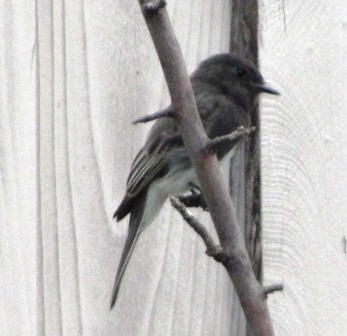
Crew Cut, our resident black phoebe, nests under an eve of the old chicken house; the male teaches its young to catch insects on the wing
Yesterday, I spotted the black phoebe pulling a piece of coir from a wall planter for its nest. These peaceful birds make a sound of tsip or fi-bee, fi-bee and can rise to roughly 50 feet to sing to a female.They range from California to central Texas, and even venture all the way to Argentina.
In the tallest eucalyptus on the acre that stands vacant behind our property, a pair of hawks are also nest-building. My farmette lies in their flight path. Not a good thing to see–hawks swooping down over my chickens and then rising to their lofty nest.
I threw some wildflower seed in beds over the weekend and then, after spotting my neighbor’s errant hen who flew to our yard, I began to regret my action. What can I do now but hope that she’ll not devour the seeds with her constant hunting and pecking?
Last night, I could have sworn I heard the pitter-patter of raindrops against the stone patio floor. With a steaming mug of coffee in hand at four o’clock this morning, I ventured outside and sure enough . . . it was still sprinkling. Hooray! It’s our first spring shower!
So, with all the nest-building and Mother Nature dropping a shower upon us, I know the wildflowers are blooming, too. That means the honeybee season is upon us. My neighbor has already had a bee swarm. I’m not ready, but I can’t stop Mother Nature from beginning a new cycle of seasons just because I don’t yet have my new honey frames assembled. That’s not how it works. Ready or not, spring has arrived.
Finding Surprises in my December Garden
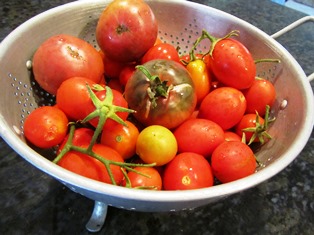
Open-pollinated, heirloom tomatoes produced lots of tasty fruit over the summer, but . . . in December?
It’s the second week of December and the Winter Solstice is about to arrive next week. Walking through the bleak garden landscape, I wasn’t expecting any of my summer plants to still be producing. But surprise, surprise.
A cluster of red grape tomatoes were still clinging to a vine that had become overgrown by weeds. Not only was fruit still hanging on the vine, but the plant was setting up new blooms. I can only assume the reason for that is that we’re having unseasonably warm temperatures in the Bay Area.
I harvested a 10-pound bag of red and yellow onions at summer’s end. Now I’ve got a new bed where the onion heads re-seeded. I do hope these bulb onions make it through to spring. I might just build a cold frame over them.
In raised beds, the jalapeno and Thai chili peppers that wilted and drooped during the terrible drought this summer have responded to recent rains with lots of ripe peppers and also new blooms.
It’s very strange as these babies need water and high heat; our Bay Area temperatures are hanging in the 60s Fahrenheit during these early days of December.
I harvested the pumpkins and squash but hadn’t yet pulled out the old vines for composting. The hard-skinned pumpkins and squashes can be peeled, cut into cubes, and frozen for use later in culinary creations such as soup.
Further on, I picked the last of the persimmons and pomegranates. These are my favorite fall fruits. And if you’ve ever dropped ripe pomegranate seeds onto the ground, you’ll soon see that the chickens love them, too.
Having uncovered all the garden’s surprises, my thoughts turn to how I’m going to lay out the garden next year and which heirlooms to grow. The garden soil needs to rest as we Bay Area gardeners welcome the rain now that the Pacific storm door has finally opened.
To-Do List of Chores for the Fall Garden
From my office widow, I look out over what once was a lush and thriving garden. Not so today.
I can hardly bear to gaze upon the sorrowful, dried tomato vines that for me have come to symbolize the severity of the extreme drought on California gardens.
Now that fall will soon arrive, I’ll toss onto the compost pile those vines along with others from pumpkins and hard-shelled squash.
So with the garden cleared, I’m thinking ahead to next year, ever hopeful we’ll get rain rather than a repeat of dry conditions like this past year.
To ensure the viability of our fruit trees, citrus trees, and various berries through the fall and winter, there is a spray regimen to be initiated. I’ll add it to my long list of chores that will need to be done.
MY FALL CHECKLIST FOR THE GARDEN
Turn the soil, add amendments like compost to hold in the water.
Prepare new beds.
Build cold frames and 4- x 6- foot boxes for new raised beds.
Cut the canes of blackberries (berries only set up on two-year-old canes that won’t again produce; cut to ensure new fruiting canes will take their place).
Prune away the spent floricanes of red raspberries, once they’ve produced fruit.
Clean up around the bases of all trees and evergreen plants; add mulch.
Also remove all leaves at the base of all fruit trees and dispose.
Remove rose leaves after blooming season, cut canes to 18 inches, and spray for diseases and pests.
Stake young trees so they’ll survive windy winters, growing straight and tall.
Treat the trees with an organic spray (one containing copper and protector oil) to prevent fungal disease and pests.
Get out the frost cloth in readiness to cover tender citrus trees.
Prune back the hydrangeas.
Plant fall bulbs for spring flowering.
One Curious Chicken and a Five-Gallon Pot
Rhody, the friendliest, most communicative chicken I’ve ever owned is the smallest in my flock of little hens. Barely 16 weeks old and not yet laying eggs, she would be a teenager in human years, I suppose. And like a teenager, she is curious and appears to thrive on new experiences.
Yesterday, the Rhode Island Red’s curiosity got her into a hot spot, literally.
The blood orange sun had nearly disappeared over the farmette’s western fence when I noticed a chicken missing from the flock. I was sitting outside trying to feel cool for it had been a searing hot day. As dusk set in, I noticed the chickens moving toward the hen house.
It didn’t take long to figure out that Rhody wasn’t among them. Panic set in as I recalled a couple of hawks circling the farmette earlier. I ran inside and woke my husband from his nap and the two of us set out on a search.
We covered all of our property and then ventured into the neighbor’s acre. We found no chicken feathers that might indicate a tussle with a hawk and my spirits should have been buoyed by that . . . but I imagined other terrible scenarios.
Fighting back tears, I followed my husband back through the gate to our farmette. Not about to give up the search, I retraced my steps to the garden. On the way, I kicked over an upside down black container that had held a five-gallon fruit tree.
And there stood Rhody. She remained frozen like she was as stunned to see me as I was to find her. She must have been under that container during the hottest hours of the day without water or food. She seemed weak, but not as bad off as I would have expected being trapped in 90-plus degree heat.
She managed to wobble back to the hen house on her own two legs. Eschewing the perch, she crouched down for the night in a straw-lined nesting box.
This morning, curious Rhody was the first out of the chicken house. As she made a beeline for the garden, I found myself remembering that old adage about how curiosity can kill a cat. In Rhody’s case, it almost cooked a chicken!
Yellow-Rumped Warbler and Other Songbirds Act Like It’s Spring
It’s the middle of January but tell that to Mother Nature whose songbirds are singing like it is spring. With our temperatures expected to exceed 70 degrees Fahrenheit in parts of the Bay Area today, the birds are gathering around feeders and fountains and the bees are buzzing about, too.
While having coffee on the patio this morning, I had the privilege of being visited by a variety of winged friends, some seemingly oblivious to me and my camera.
The woodpecker announces himself with the familiar rat-ta-tat-tat while the yellow-rumped warbler and other songbirds hang out in the firethorn bush, in the oak trees, and at several fountains we’ve placed at the rear of our farmette.
There’s a lot of bee traffic today. With warm days forecast for the next week or two, the bees could get the wrong idea and swarm. That would undoubtedly surprise the local backyard bee hobbyists.
So while I love the warm weather–especially when I read about the polar temperatures causing such misery in the Midwest and along the East Coast–like many Californians, I am beginning to worry about the looming possibility of a drought this year and mandatory water rationing.
But, then again, there’s something magical about hearing songbirds trilling in the dead of winter when the fruit trees in the orchard and the roses lining the path to the front door remain soundly asleep. I think I’ll have another cup of coffee and sit for a while longer.
 Facebook
Facebook Goodreads
Goodreads LinkedIn
LinkedIn Meera Lester
Meera Lester Twitter
Twitter






